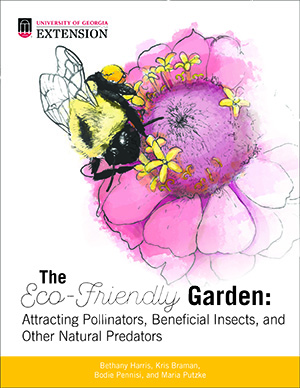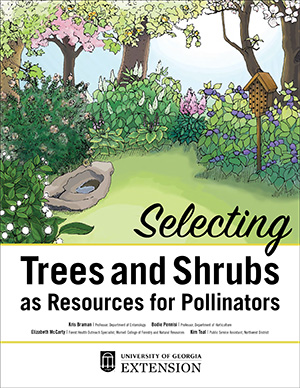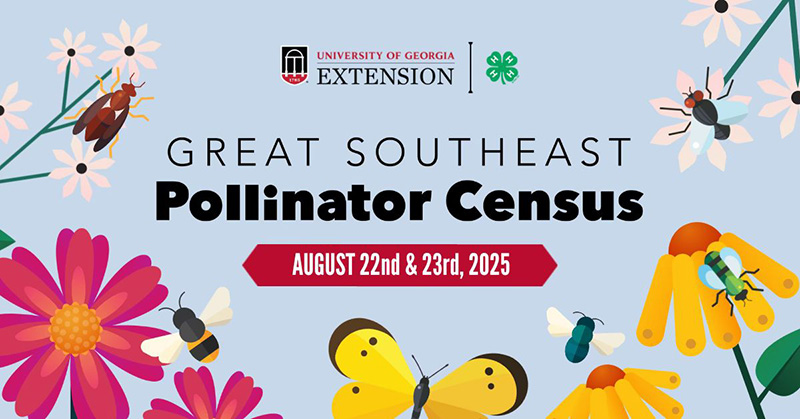Photo above: Several primary plant selections include Rudbeckia (left), Glossy Abelia, Asters (right), and Coreopsis species.
Selecting the right plants.
Let’s talk about pollinators and beneficial insects in the landscape. Many of our ornamental landscape plants serve as nectar and pollen sources and as habitat for beneficial insects and pollinators. Pollinators, like bees, help plants reproduce by transferring pollen, which leads to fruit and seed production. Beneficial insects, often called "good bugs," feed on harmful pests that damage plants. While spiders aren’t technically insects but rather are arthropods—they have eight legs instead of six—they're included in this group because they also help control pest populations. Together, pollinators and beneficial insects play key roles in maintaining a healthy landscape ecosystem.
Providing a variety of nectar sources helps sustain insect populations, which in turn supports plant health. Understanding the interactions between plants and insects—like how flowers attract both herbivores and their predators—is key to fostering a balanced, biodiverse environment.
An aesthetically appealing landscape that attracts and supports beneficial insects can minimize the use of pesticides, making it a pollinator-friendly contribution to conservation efforts. Using more perennials, annuals, and native plants that draw pollinators and natural predators helps control pests naturally and enhances wildlife and beneficial biodiversity in the landscape.
Plant considerations and selection
Several studies at the University of Georgia have focused on assessing different ornamental plants and their attributes (flower color and shape) and how they affect insect activity in landscapes and greenspaces, particularly pollinators and beneficial insects. Promoting biodiversity in residential and commercial landscapes starts with selecting the right plants that attract these beneficial insects. When incorporating plant material, it is important to think about providing pollen and nectar sources, host plants for butterflies and moths, as well as offering a variety of habitable vegetation from groundcovers and perennials to trees and shrubs that serve as habitat sites throughout the seasons. Nectar and pollen resources for native bees should be provided throughout the growing season, ensuring that plants have over-lapping bloom times to provide a consistent source of pollen and nectar. This is important for many bees, including bumble bees, that require an unbroken succession of blooms all summer to build up their local populations. It is crucial that landscape designers and installers consider plants that will bloom throughout spring, summer, and fall. Several primary plant selections include Rudbeckia, Glossy Abelia, Asters, and Coreopsis species.
- Rudbeckia hirta and Rudbeckia fulgida are hardy selections in the landscape due to their drought tolerance and their ability to attract an impressive variety of pollinator and butterfly species. Blooming from summer to fall, these plants provide vibrant color while also supplying nectar and pollen to native bee species, including longhorn and sweat bees.
- Glossy Abelia (Abelia x grandiflora) varieties are another great pollinator and beneficial insect selection with their tubular flowers and long season of continuous nectar from late spring into fall. This plant not only serves as a nectar source but additionally serves as a shelter and can be used to provide habitat.
- As a mid- to late-fall bloomer, Asters including the Woods Pink Aster (Symphyotrichum dumosum ‘Woods Pink’) and Smooth Aster (Symphyotrichum leave) are other options that provide nectar at the end of the growing season when other blooms may be scarce. These plants are a great addition to a landscape due to their hardy nature and the numerous insects they attract.
- With its daisy-like flowers and rich source of nectar, Tickseed or Coreopsis species can be a long-lasting resource for butterflies and other pollinators. It is drought tolerant and there are numerous cultivars that provide a variety of color and texture to any landscape bed.
Learn more with these free publications from UGA:
In 2019, the Great Southeast Pollinator Census launched to address a gap in knowledge about insect ecosystems, particularly pollinators throughout the state of Georgia.
The Great Southeast Pollinator Census allows citizens, educators, community members, and the green industry to participate in citizen science while also promoting the importance of pollinators and the ecosystem services they provide to the landscape and other areas of urban agriculture.
The project has three main goals:
- to provide education on sustainable pollinator habitats;
- to increase public entomological literacy; and
- to generate valuable data on pollinator populations.
The first statewide Great Georgia Pollinator Census took place in August 2019, with over 4,000 participants contributing to the effort. Today, this project has expanded across the southeastern U.S., inspiring the public to become pollinator advocates. With many other states including South Carolina, North Carolina, Florida, Alabama, and Tennessee now participating in the Census, the project emphasizes the importance of public engagement in scientific research and environmental stewardship. In 2024, there were over 17,000 counters and over 775 new pollinator landscapes and gardens established.
The success of the Census has also led to the creation of The Great Pollinator Count, a children's book by Susan Richmond, which celebrates community science and pollinator conservation. The book is being integrated into educational programs across Georgia and beyond, further promoting awareness and action. Through these efforts, Community Science Counts demonstrates how collaborative citizen engagement can lead to meaningful environmental impact and educational enrichment.
Becky Griffin, School and Community Garden Coordinator at the Center for Urban Agriculture and leader of the Great Southeast Pollinator Census, remarks,
“You don’t need a degree in entomology to participate. Our pollinators matter, and everyone’s count matters. In Georgia alone, pollinators contribute $600 million to the economy each year.”
Whether you are participating in the next Pollinator Census, educating your customers about the upcoming Census, or showing your support at a pollinator counting event in your local community, there are so many ways to be a part of the Great Southeast Pollinator Census and pollinator conservation efforts throughout the State.
Learn more: gsepc.org


